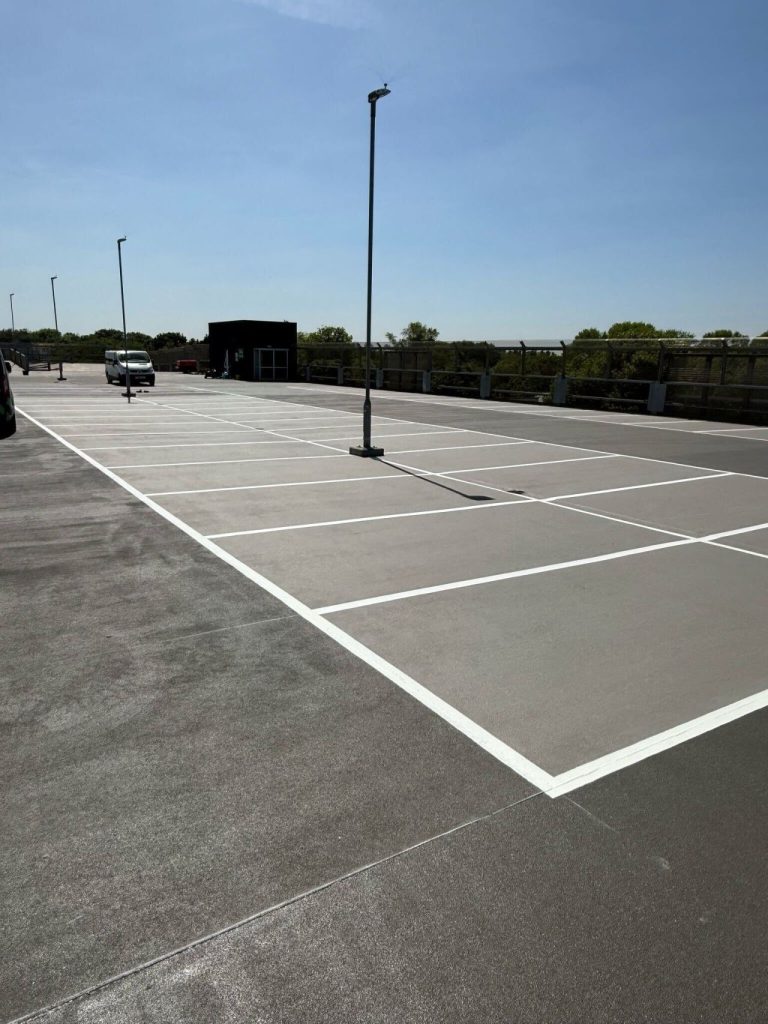How Do You Maintain Line Markings After Installation?

Even the best installations need a plan for line marking maintenance. With routine inspection, the right cleaning methods, and timely touch-ups, your car parks, warehouses, and access routes stay clear, safe, and compliant year-round.
At a Glance: Your Maintenance Plan.
-
Inspect regularly: schedule checks (see below) and log issues.
-
Clean correctly: match methods to indoor/outdoor areas.
-
Prioritise high-wear zones: crossings, junctions, EV/accessible bays, loading doors.
-
Refresh on time: touch up before heavy fading to avoid full re-marks.
Inspection: How Often and What to Check.
-
External car parks/roads: inspect quarterly (monthly for busy retail/logistics).
-
Warehouses & internal routes: inspect monthly or per shift pattern.
-
Look for: fading/low contrast, frayed edges, lifting/peeling, contamination (oil, rubber, dust), obscured symbols/arrows, poor drainage causing premature wear.
Tip: Plan inspections before seasonal peaks and after heavy weather or site works.
Cleaning & Care (Do/Don’t).
External (car parks, yards)
-
Do: periodic pressure washing; use fan nozzles and moderate pressure; pre-treat oils.
-
Don’t: blast too close to edges or use harsh solvents that soften resin systems.
Internal (warehouses, factories)
-
Do: mechanical scrubber-dryers, neutral pH detergents, routine dust control.
-
Don’t: use aggressive chemicals or abrasive pads that scour coatings.
Clean surfaces keep contrast high and extend service life.
Touch-Ups vs Full Re-mark.
Choose touch-ups when: localised fade, clear layout intact, edges sound.
Choose a full refresh when: widespread fade/patchiness, layout changes, poor adhesion, or contamination you can’t recover with cleaning.
A practical trigger: if visibility/contrast is down by ~30–40% or symbols aren’t instantly readable, schedule a refresh.
Materials & Typical Lifecycles (Guide).
-
Thermoplastic (external): quick reopen; robust for car parks/roads. Typical refresh 1–3+ years, usage dependent.
-
MMA / cold plastic (external/internal): premium durability/chemical resistance; longer intervals in high-wear areas.
-
Epoxy/PU (internal): excellent for controlled environments; plan periodic re-seals in heavy forklift lanes.
Actual intervals depend on traffic, turning loads, chemicals, UV, drainage, prep quality, and cleaning regime.
Protect High-Wear Areas.
-
Specify high-friction/anti-slip systems at crossings and ramps.
-
Use heavier build or MMA at junctions and loading doors.
-
Improve drainage and turning geometry to reduce scuffing.
-
Add a maintenance allowance for fast touch-ups between full programmes.
Our Maintenance Approach (UK-Wide).
-
Survey & plan: we assess traffic, substrates, and access windows.
-
Correct methods: cleaning, removal/black-masking, shot blasting, priming, and the right coating for each zone.
-
Low-disruption delivery: night/out-of-hours works; phasing to keep operations running.
-
Ongoing support: agreed refresh schedules to protect visibility and compliance.
Why Choose C&R.
As one of the UK’s leading specialists in line marking, surface preparation, coatings, and cleaning, C&R delivers expert advice, professional results, and long-lasting performance nationwide.
Over 30 Years’ Experience
Trusted nationwide by major brands and local authorities.
Fully Accredited & Insured
Working to UK safety and environmental standards.
Complete Start-to-Finish Service
From design and preparation to marking and aftercare.
Nationwide Coverage
Responsive teams operating across England, Scotland, and Wales.
